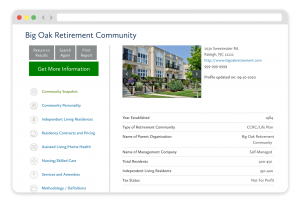Research frequently shows that “aging at home” is the senior living preference for a majority of older adults. Yet some decide that a retirement community, such as moving to a CCRC (continuing care retirement community aka life plan community), better meets their long-term senior living goals.
Among those who choose a CCRC, many cite access to a full continuum of care services as a top selling point. In fact, according to a number of consumer surveys conducted by myLifeSite over the years, “access to care” is typically the number one reason that people choose a CCRC over other senior living options, including staying in the home.
However, there are other factors that may hold people back from making a decision about a retirement community like a CCRC or cause them to delay their move to one, according to our most recent survey data. Not surprisingly, near the top of that list is not wanting to leave the comfort and independence of their existing home (37.3% of respondents). But number one on the list of things that hold people back is concern about cost and the long-term affordability of living in a CCRC or other type of retirement community (41.3% of respondents).
>> Related: 2 Key Factors in Senior Living Cost Comparisons
Is aging at home really cheaper?
We often hear people say that, while they would like to move to a CCRC, they believe staying in their home will be less expensive on a month-to-month basis. But is this actually the case? Maybe, maybe not. Consider the following:
Mortgage or rent
The first thing to consider is your current home’s mortgage or rent, which is most people’s biggest monthly expense. Of course, many seniors are living in a home that has already been paid off. In this case, the home’s equity is a common source of funding for a CCRC entry fee as well as potentially the monthly fees charged by a CCRC or other type of retirement community.
Utilities
Utilities are another considerable expense for those who live on their own. The cost for your home’s power, water, phone, cable, internet, and other utilities can add up pretty fast. When living in a CCRC or other retirement community, these costs may be rolled into your monthly fee. You will want to ask this question to verify when visiting retirement communities.
Insurance, taxes, and other home expenses
Homeowners insurance and property taxes also can be quite expensive for homeowners, especially in high-tax states. Again, you will want to check with the retirement community you are considering, but both of these expenses may be reduced if not eliminated at a CCRC or other type of senior living community.
Other miscellaneous costs that come with owning a home like trash removal, snow removal, HOA fees, lawn and landscaping services, housekeeping services, gym memberships, and most home repair costs will likely be included in the monthly fee for the majority of CCRCs or other retirement communities as well.
Then there is the expense of home upkeep and unexpected costs that come with homeownership. The price of things such as replacing the roof or HVAC system, or having a pipe burst, for example, all add up over time and must be factored into your cost comparison analysis.
Food
As for your monthly food expense — while not all retirement communities have on-site dining, almost all CCRCs will include at least one meal per day within their dining facilities as part of the monthly fee.
Retirement community meal plans are becoming more flexible in many cases, though the options can vary from one community to the next. But do keep in mind that there will likely be an additional cost for meals if a CCRC resident is living in the healthcare center, thus requiring three meals be delivered each day.
>> Related: “…but I love my home”: Is Staying in Your House the Right Move?
The biggest senior living cost difference
When calculating the cost of moving to a retirement community such as a CCRC versus aging in the home, perhaps the number one cost to consider is care services.
Generally speaking, for those who opt to remain in their home (or who choose a retirement community that doesn’t provide care services), there are two options for in-home care. You can either hire someone to provide the services you need, or you can have an unpaid loved one perform those caregiving duties.
The Genworth Annual Cost of Care Study reveals that the 2025 median hourly cost for homemaker or home health aide services hired from a home care agency is projected to be $31.83 and $35.01, respectively. So, for just 20 hours of in-home care per week (part-time care), the cost can range from around $2,758 to $3,034 each month. Should someone require 24-hour care at home, that cost can easily top a staggering $25,000 a month!
>> Related: Home- and Community-Based Services: An Increasingly Popular Care Option
The true cost of unpaid caregiving
Think having an unpaid loved one — a spouse, partner, or adult child — serve as a caregiver is the less expensive option? Well, maybe for your checkbook, but the cost can still be incredibly high for that family caregiver — financially, emotionally, and physically..
According to 2023 research by AARP, in the prior three years, approximately 48 million Americans have provided unpaid care to a loved one aged 50 or older. And additional data collected by AARP revealed that the average unpaid family caregiver allocates about 26% of their own income to caregiving activities — from household expenses (52%) to medical costs (17%). Only 5% of family caregivers reported incurring no caregiving-related expenses in the past year.
In addition to these financial losses, there are other well-documented non-monetary costs often experienced by these unpaid family caregivers. In the 2023 AARP survey, over a third of family caregivers reported experiencing emotional stress while caring for an aging loved one. Additionally, 40% said they rarely or never feel relaxed, and more than half (56%) of caregivers said the role makes it hard to prioritize their own mental health.
>> Related: The Unexpected Costs of Caring for an Aging Parent
Aging at home or moving to a CCRC: The full picture
For those who think they will save money by aging at home, it is important to keep all of these statistics in mind. This decision may or may not save you money as compared to moving to a CCRC or other type of retirement community.
Should you require in-home care from a paid caregiver, those costs can add up rapidly (and those prices are only going up each year). If relying on loved ones for any necessary long-term care is your cost-saving plan, it is clear that “unpaid” caregiving does indeed have a price.
The reality is those costs get transferred to the next generation in the form of lost income and/or added expenses, as well as negative health impacts.
Originally posted February 25, 2019; updated January 28, 2025

FREE Detailed Profile Reports on CCRCs/Life Plan Communities
Search Communities






